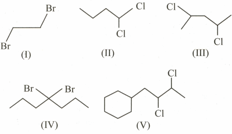EASY
Earn 100
Calculate the number of secondary () alkyl halide in nature (except stereoisomers if any) in the following given possible isomers of Pentyl chloride ().
50% studentsanswered this correctly
Important Questions on Haloalkanes and Haloarenes
MEDIUM
MEDIUM
MEDIUM
MEDIUM
EASY
HARD
The CORRECT match of compound in Column with density in Column is
| Column A | Column B | ||
| p | i. | ||
| q | ii. | ||
| r | iii. | ||
| s | iv. |
EASY
HARD
MEDIUM
MEDIUM
MEDIUM
MEDIUM
MEDIUM
MEDIUM
MEDIUM
EASY
The total number of compounds amongst the following, that can be classified as vicinal dihalides will be

MEDIUM
The correct order of rate of reaction is:

MEDIUM
MEDIUM


